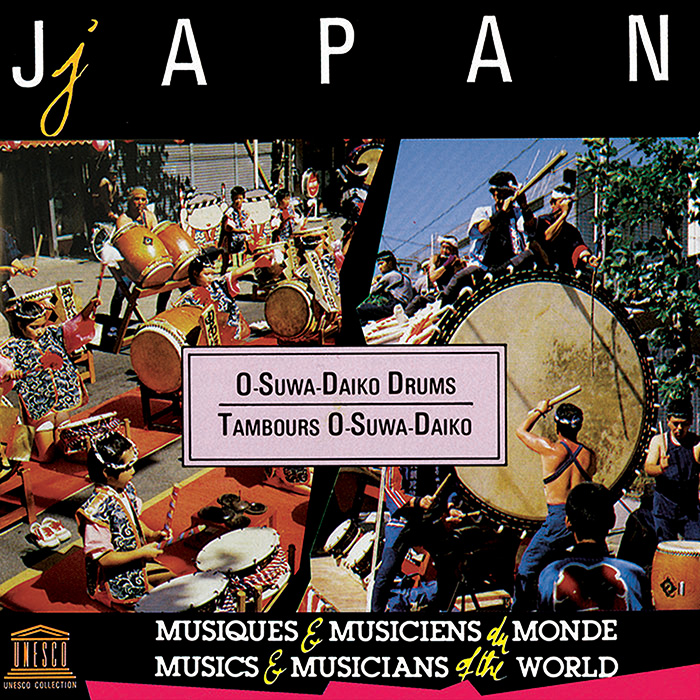-
UNESCO Collection Week 48: Cultural Evolution and Innovation in Japanese Music
This week’s UNESCO releases, Japan: O-Suwa Daiko Drums and Japan: Koshimaru Izatsuya – Master of Kawachi Ondo Epics, explore the innovative works of two master musicians. Both albums highlight Japan’s rich musical history and traditions while marking their evolution and innovation.
GUEST BLOG
by Ender Terwilliger
Japan: O-Suwa-Daiko Drums and Japan: Koishimaru Izutsuya—Master of the Kawachi Ondo Epics, from the UNESCO Collection of Traditional Music feature recordings of two 20th century masters and innovators of Japanese performing arts. On the first album, Oguchi Daihachi leads his taiko drum ensemble, and on the second, Izutsuya Koishimaru performs his epic narratives. Each recording represents the culmination of these masters’ decades of development, during which they not only cultivated but put a personal stamp on their traditional art forms.
Oguchi comes from a line of musicians who trace their lineage back to the 16th century. Oguchi specializes in the folk art of Nagano and was a performer and composer of Kagura, Shinto ceremonial dances. Though he also trained as a jazz musician, he is famous for his role in pioneering new forms of traditional drumming. In 1951, Oguchi founded the first kumi-daiko, or taiko drum ensemble. He drew inspiration from existing drumming traditions and rhythms which accompanied theater, and Buddhist ceremonies, but created an independent ensemble, placing the drums at the forefront. He also added drums of different sizes to the group.This recording from 1978 features the O-Suwa Daiko Society under Oguchi’s direction. While innovative, he also strove to preserve. He is credited with rediscovering the Suwa style of performance and incorporating it into his new form. The regional origin of this drumming can be traced back to the area around Lake Suwa, in the heart of Nagano prefecture. There, ceremonial dances were performed around the local Shinto shrines to summon rain or to destroy harmful animals. These musicians were often called upon during times of war with the aim of increasing troop morale before battles. The members of this ensemble, much like the heritage bearers who came before them, also perform in multiple settings. The O-Suwa Daiko Society’s members are all practitioners of religious taiko drumming as well as the newer secular tradition heard on this CD.
AudioThe detailed liner notes allow the listener to appreciate the historical backgrounds of the pieces as well as listen for the drums’ mimicry of nature sounds, from horse hooves to thunder. The final track (“Suwa-Ikazuchi”) exemplifies the historic roots of the Suwatradition along with its modern adaptation. “Suwa Ikazuchi”, or The Thunder of Suwa, depicts a violent storm in the Suwa Valley and was originally performed at ceremonies to summon rain. Later it was adapted to military ceremonies to promote victory and became associated with a famous battle on the island of Kawanakajima. The subtitle to this piece (“Shingen Hossho Kuruma-gatame”) references a type of military attack Takeda Shingen used, advancing three successive lines of troops to achieve victory. After the first two iterations of this piece, religious and then military, we hear O-Suwa Daiko Society’s third modern interpretation.
Japan: Koishimaru Izutsuya—Master of the Kawachi Ondo Epics is a previously-unreleased recording of another brilliant artist and founding father of a post-war Japanese tradition. Izutsuya developed his own style of Kawachi Ondo, a form of epic recital still performed in Japan today that fuses together multiple epic traditions. Kawachi (a plain near modern-day Osaka) Ondo (call-and-response song form) began as an outdoor dance at Obon, the annual Japanese Buddhist celebration of the spirits of ancestors. The genre is distinctive in its use of varying melodic patterns, epic narrative, and duration of up to 40 minutes.In its postwar form, cultivated by Izutsuya and other influential singers, Kawachi Ondo became an indoor genre, suitable for city theaters. Singeres were often accompanied by shamisen, a three-stringed lute, taiko drums, and sometimes electric guitar. Most practitioners are amateurs. While the songs are passed down from master to student, they are still improvised and altered during performance, allowing for individual interpretation and incorporation of current events. Because Kawachi Ondohas an association to gangsters, and to poorer Japanese citizens who attended outdoor performances, the public views the genre as somewhat marginalized.
This record, featuring taiko drums, shamisen, and a female vocalist, was made in 1991 just months before Izutsuya's death.
On track 2, “Service for the Buddha: Hymn to Jizo,” Izutsuya begins by commenting on his raspy voice. He was already ill, but nevertheless he playfully resolves to, “squeeze out this raspy old voice/And sing with all my might.” His long poem goes on to evoke nature and endeavoring to attain Buddhahood. Mortality was evidently on his mind as he sang:
A young child who smiles in the morning
May become smoke by evening
How sadly transient we all are
Day by day, the mortal world grows more and more distant
Year by year, dying grows closerAll three pieces on this CD are beautifully performed and recorded. Together these two albums are not only great listens, but intriguing contrasts of how taiko drum has established roles in the evolving performing arts of Japan.
Ender Terwilliger is a PhD student at Wesleyan University who received a masters in musicology from University of Oxford. He first began research as an ethnomusicologist on a Freeman grant to contrast Buddhist music traditions in Japan, Korea, and China. He then spent a year traveling on a Watson Fellowship to study Chinese music outside the mainland. For his dissertation, he is researching Taiwanese musical identity and the use of Chinese instruments in popular music in Taipei. He is currently co-director of the Chinese Music Ensemble at Wesleyan.
UNESCO Collection Week 48: Cultural Evolution and Innovation in Japanese Music | Smithsonian Folkways Recordings



